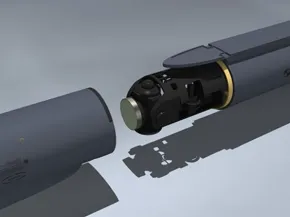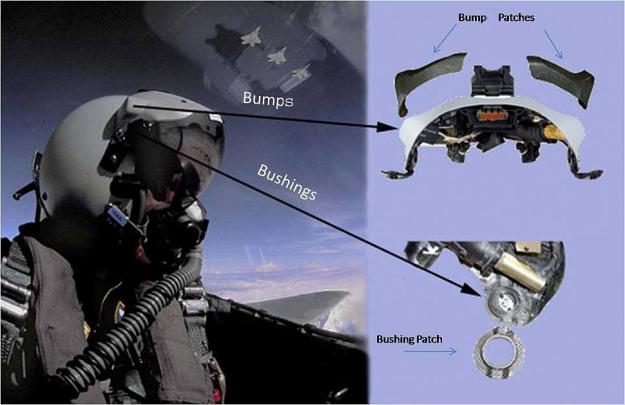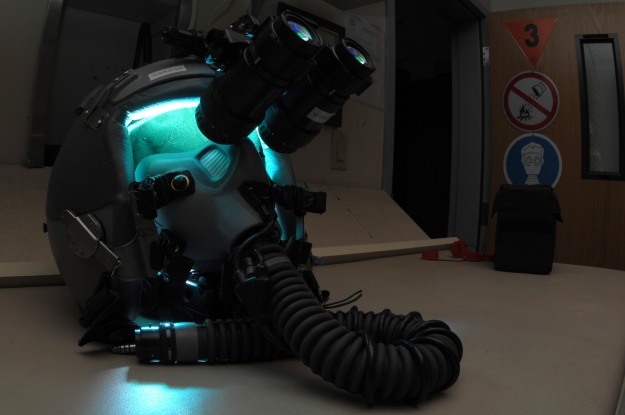Media/Public Contact:
Charles Taylor (703) 601-3859 / Paul Ebner (703) 601-3670
Transmittal No: 10-43
WASHINGTON, October 20, 2010 – The Defense Security Cooperation Agency notified Congress today of a possible Foreign Military Sale to the Government of Saudi Arabia of:
84 F-15SA Aircraft
170 APG-63(v)3 Active Electronically Scanned Array Radar (AESA) radar sets
193 F-110-GE-129 Improved Performance Engines
100 M61 Vulcan Cannons
100 Link-16 Multifunctional Information Distribution System/Low Volume Terminal (MIDS/LVT) and spares
193 LANTIRN Navigation Pods (3rd Generation-Tiger Eye)
338 Joint Helmet Mounted Cueing Systems (JHMCS)
462 AN/AVS-9 Night Vision Goggles (NVGS)
300 AIM-9X SIDEWINDER Missiles
25 Captive Air Training Missiles (CATM-9X)
25 Special Air Training Missiles (NATM-9X)
500 AIM-120C/7 Advanced Medium Range Air-to-Air Missiles (AMRAAM)
25 AIM-120 CATMs
1,000 Dual Mode Laser/Global Positioning System (GPS) Guided Munitions (500 lb)
1,000 Dual Mode Laser/GPS Guided Munitions (2000 lb)
1,100 GBU-24 PAVEWAY III Laser Guided Bombs (2000 lb)
1,000 GBU-31B V3 Joint Direct Attack Munitions (JDAM) (2000 lb)
1,300 CBU-105D/B Sensor Fuzed Weapons (SFW)/Wind Corrected Munitions Dispenser (WCMD) 50 CBU-105 Inert
1,000 MK-82 500lb General Purpose Bombs
6,000 MK-82 500lb Inert Training Bombs
2,000 MK-84 2000lb General Purpose Bombs
2,000 MK-84 2000lb Inert Training Bombs
200,000 20mm Cartridges
400,000 20mm Target Practice Cartridges
400 AGM-84 Block II HARPOON Missiles
600 AGM-88B HARM Missiles
169 Digital Electronic Warfare Systems (DEWS)
158 AN/AAQ-33 Sniper Targeting Systems
169 AN/AAS-42 Infrared Search and Track (IRST) Systems
10 DB-110 Reconnaissance Pods
462 Joint Helmet Mounted Cueing System Helmets
40 Remotely Operated Video Enhanced Receivers (ROVER)
80 Air Combat Maneuvering Instrumentation Pods
Also included are the upgrade of the existing Royal Saudi Air Force (RSAF) fleet of seventy (70) F-
15S multi-role fighters to the F-15SA configuration, the provision for CONUS-based fighter training operations for a twelve (12) F-15SA contingent, construction, refurbishments, and infrastructure improvements of several support facilities for the F-15SA in-Kingdom and/or CONUS operations, RR-188 Chaff, MJU-7/10 Flares, training munitions, Cartridge Actuated Devices/Propellant Actuated Devices, communication security, site surveys, trainers, simulators, publications and technical documentation, personnel training and training equipment, U.S. government and contractor engineering, technical, and logistical support services, and other related elements of logistical and program support. The estimated cost is $29.432 billion. Source dsca.mil
Boeing received $46 million contract modification to perform interim contractor support for the new Saudi Arabia’s F-15SA: Here
Excerpt
Boeing received a $46 million contract modification from the U.S. Air Force to perform interim contractor support for Saudi Arabia’s recently purchased F-15s.
Interim contractor support refers to an agreement wherein a service will defer an investment due to a lack of technological capabilities, such as equipment spares or technical data. Boeing is expected to complete this service for Saudi Arabia by the end of March.
Instead of the tactical electronic warfare system (TEWS) in the Strike Eagle the Silent Eagle makes use of BAE’s Digital Electronic Warfare System (DEWS)
DEWS uses digital radio-frequency memory (DRFS) technology which is said to have substantially better performance and reliability than the Analog TEWS system. The system has the ability to listen over a frequency band constantly without the need to scan it and the advanced antenna systems can obtain more accurate data with regards to the measurement of bearings. Targets acquired by the DEWS are fused with radar and infrared search and track (IRST) data and displayed on the large format cockpit displays.
The system was designed by implementing lessons learned during the development of the electronic warfare systems for the F-22 and F-35 JSF.
 The F-15 Silent Eagle’s (F-15 SE) Basic Sensor Suit
The F-15 Silent Eagle’s (F-15 SE) Basic Sensor Suit
The system utilizes various sensors located in sections of the tail fins, wings and the underside of the airframe as well as a digital radar warning receiver (RWR). The Silent Eagle also contains an advanced jamming system which according to Boeing, allows the aircraft to jam enemy radar systems while still allowing it’s own radar and RWR to operate.
The actual systems contained within the Silent Eagle make it more than capable of entering the battle arena with the best of Russia or anyone else. Source onfinalofficial.wordpress.com
| General data: | |
|---|---|
| Type: ESM | Altitude Max: 0 m |
| Range Max: 222.2 km | Altitude Min: 0 m |
| Range Min: 0 km | Generation: Late 1980s |
| Sensors / EW: |
|---|
| AN/ALR-56C TEWS – ESM Role: RWR, Radar Warning Receiver Max Range: 222.2 km |
Link 16 data net system
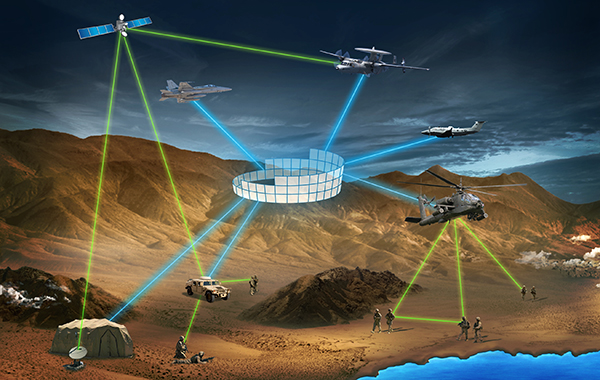 Image: globalmilitarycommunications.com
Image: globalmilitarycommunications.com
ViaSat’s team is leading the transformation in Link 16 Airborne Terminal technology by being the first to upgrade the design of many components of the terminal to provide greater flexibility, enhanced technological capabilities, decreased cost and improved reliability. Embedded modules provide COMSEC and TACAN.
 Image: researchgate.net
Image: researchgate.net
Through extensive use of reprogrammable components and a modular VME architecture, we’ve provided a lower cost design while also allowing for future requirements. Our terminal provides all operational modes of the Link 16 waveform, and implements all required Multifunctional Information Distribution System (MIDS) host interfaces for both U.S. and Coalition integration. Our hardware implements Enhanced Throughput, a new capability that can increase coded data throughput from its current maximum of 115.2 kbps to over 800 kbps. Host interfaces and operational employment of this capability are still in the planning stages.
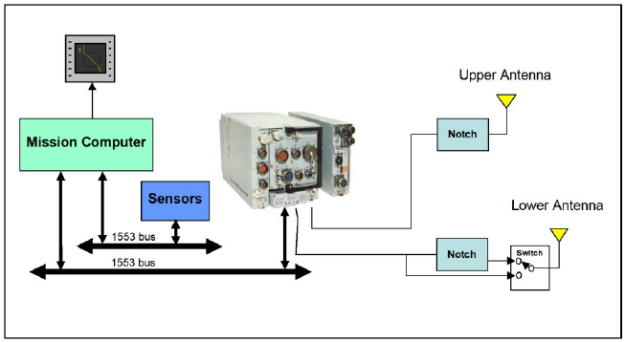 Image: researchgate.net
Image: researchgate.net
Together with Harris and European Aeronautic Defense and Space Company (EADS), ViaSat is delivering a family of combat-proven, fully qualified, and EMC-Certified Link 16 MIDS terminals to U.S. Forces and Coalition partners under contracts to the Navy MIDS International Program Office (IPO) and other commercial customers. Source viasat.com
The F-15SA (Saudi Advanced) configuration remains as stated in the October 2010 notification to Congress. Compared with the latest production F-15SGs for Singapore, the F-15SA includes the same Raytheon APG-63(v)3 AESA (active electronically scanned array) radar and GE F110 improved-performance engines worth $7 billion, but adds a fly-by-wire flight control system and a digital electronic warfare system from BAE Systems.
U.S. officials repeated earlier assurances that the package would not erode Israel’s “qualitative military edge.” Of note, therefore, the F-15SA does not include the low-observability modifications that Boeing has been marketing as the “Silent Eagle.” The package also does include the Lockheed Martin AAS-42 infrared search and track system and a large array of weapons, including Boeing AGM-84 Block II Harpoon anti-ship missiles. Source ainonline.com
This stunning air-to-air video shows the most advanced variant of the Eagle recently delivered to the Royal Saudi Air Force (RSAF).
The Royal Saudi Air Force (RSAF) has officially received its first Boeing F-15SA multirole jets in a ceremony celebrating the 50th anniversary of the King Faisal Air College in Riyadh on Jan. 25, 2017.
Equipped with the APG-63V3 Active Electronically Scanned Array (AESA) radar, a digital glass cockpit, JHMCS (Joint Helmet Mouted Cueing System), Digital Electronic Warfare System/Common Missile Warning System (DEWS/CMWS), IRST (Infra Red Search and Track) system, and able to carry a wide array of air-to-air and air-to-surface weaponry, including the AIM-120C7 AMRAAM (Advanced Medium Range Air-to-Air Missile) and the AIM-9X Sidewinder air-to-air missiles, the AGM-84 SLAM-ERs, the AGM-88 HARM (High-speed Anti-Radiation Missile) and the GBU-39 SDBs (Small Diameter Bombs) on 11 external hardpoints, the F-15SA, derived from the F-15E Strike Eagle, is the most advanced Eagle variant ever produced.
Back in 2010, the RSAF requested 84 new-built F-15SA jets and upgrade package for 68 existing Saudi F-15S fighters for a total of 152 multirole advanced Eagles through a Foreign Military Sale: a contract worth 29.4 billion USD that included logistics, spares, maintenance support and weapons was eventually signed on Dec. 29, 2011.
Therefore, instead of the 5th gen. F-35 Lightning II, Saudis (that already operate the 4th gen. Eurofighter Typhoon) opted for a 4.5th generation jet able to perform several missions, including SEAD/DEAD (Suppression/Destruction of Enemy Air Defenses), OCA (Offensive Counter Air) and Air Interdiction with precision guided munitions from stand-off distance.
The newest aircraft’s predecessor, the Saudi F-15S, have taken part in the air strikes in Yemen, as part of Operation Decisive Storm, the Saudi Arabian-led intervention in Yemen, since Mar. 26 2015. A RSAF F-15S crashed in the Gulf of Aden during the opening day of the air war; its two pilots ejected safely and were recovered from the sea by a USAF HH-60G rescue helicopter. Although Houthi and Iranian sources stated that the Eagle was shot down, Saudi and Arab coalition authorities denied such reports.
The first F-15SAs arrived at King Khalid Air Base (KKAB) in Saudi Arabia via RAF Lakenheath, on Dec. 13, 2016, the day after the Israeli received their first 5th generation F-35I.
The first aircraft were assigned to the 55th Sqn at KKAB.
The following epic footage (produced by Combat Aircraft’s editor Jamie Hunter and Bob Hayes) shows the first F-15SAs, flying in Saudi Arabia. Source theaviationist.com
LANTIRN navigation pods with Tiger Eye IRST systems
Navigation Pod
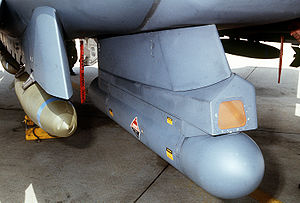
It contains a terrain-following ( TF) radar, a forward-looking infrared ( FLIR) sensor, plus a control computer, a power supply (the pod uses power from the aircraft’s power system) and an environmental control unit.
Both the TF radar and the FLIR are aimed at allowing the F-15E to make a high speed, low altitude penetratation of enemy airspace at night and/or in adverse weather conditions. These two systems give a powerful edge to the Strike Eagle when it comes to deep interdiction missions, thus making the jet an extremely capable night flying platform.
Terrain-Following Radar
The AN/APN-237A terrain-following radar is located behind the round radome forming the forward end of the pod. It is a KU band radar manufactured by Texas Instruments. When operating, it constantly scans the terrain in front of the jet and combining it with using altitude and airspeed data, it is able to generate inputs to the autopilot to maintain its pre-set altitude thus making the jet follow the contours of the terrain totally ‘hands off’, that is without inputs from the pilot. When the autopilot is not in use the TF radar is able to generate maneuvering cues for the pilot to avoid ground obstacles.
Forward Looking Infrared
The LANTIRN navigation pod contains a fixed, wide file of view (21×28 degrees), advanced 3rd generation mid-wave (8-12 micron) forward looking infrared ( FLIR) sensor. The window of this sensor can be found directly above the TF radome.
This FLIR sensor generates an infrared image of the terrain in front of the aircraft and projects it onto the pilot’s HUD. This way the pilot is able to see the terrain in front of him through the HUD in shades of green even in total darkness or in adverse weather conditions. Seeing the terrain the pilot can easily fly at high speeds very close to the ground, thus using terrain features (mountains, valleys) to avoid enemy detection. The WSO can view the same image on one of his multi-purpose display, by calling up the HUD-repeater page. Note that the repeated FLIR image is available for the WSO regardless of whether the pilot had actually chosen to put the FLIR image on the HUD or not. Source f-15e.info
AN/AAS-42 Infrared search and track (Tiger Eye IRST systems)
 IRST system is located on the weapons pylon
IRST system is located on the weapons pylon  F-14D AAS-42 – Image: sistemasdearmas.com.br
F-14D AAS-42 – Image: sistemasdearmas.com.br
Lockheed Martin’s IRST is a development of the AN/AAS-42 system that was originally carried by Northrop Grumman F-14D Tomcats. However, it has been undergoing development since then, first for the abortive pod-mounted system for the F-15 Eagle, and now further refined for the Super Hornet application. Source ainonline.com
Lockheed Martin’ Sniper pod (AN/AAQ-33)
 Lockheed Martin’s Sniper ATP (Advanced Targeting Pod) Picture: Lockheed Martin – Image: navyrecognition.com
Lockheed Martin’s Sniper ATP (Advanced Targeting Pod) Picture: Lockheed Martin – Image: navyrecognition.com
Mission
Sniper pods provide improved long-range target detection/identification and continuous stabilized surveillance for all missions, including close air support of ground forces. The Sniper pod enables aircrews to detect and identify weapon caches and individuals carrying armaments, all outside jet noise ranges. Superior imagery, a video datalink and J-series-weapons-quality coordinates provided by the Sniper pod enable rapid target decisions and keep aircrews out of threat ranges.
High resolution imagery for non-traditional intelligence, surveillance and reconnaissance (NTISR) enables the Sniper pod to play a major role in Air Force operations in theater, providing top cover for ground forces, as well as increasing the safety of civilian populations.
The Sniper pod is combat proven on U.S. Air Force and international F-15E, F-16 (all blocks), B-1, A-10C, Harrier GR7/9 and CF-18 aircraft. Lockheed Martin is also in the final stages of integrating the Sniper pod on the B-52. The pod’s plug-and-play capability facilitates moving the pod across platforms without changing software.
Features
Sniper pods include a high definition mid-wave forward looking infrared (FLIR), dual-mode laser, HDTV, laser spot tracker, laser marker, video data link, and a digital data recorder. Advanced image processing algorithms, combined with rock steady stabilization techniques, provide cutting-edge performance. The pod features automatic tracking and laser designation of tactical size targets via real-time imagery presented on cockpit displays. The Sniper pod is fully compatible with the latest J-series munitions for precision weapons delivery against multiple moving and fixed targets.
Advanced Targeting Pod – Sensor Enhancement (ATP-SE) design upgrades include enhanced sensors, advanced processors, and automated NTISR modes.
The Sniper pod’s architecture and modular design permits true two-level maintenance, eliminating costly intermediate-level support. Automated built-in test permits flightline maintainers to isolate and replace an LRU in under 20 minutes. Spares are ordered through a user-friendly website offering in-transit visibility to parts shipment.
The Sniper pod’s modular design also offers an affordable road map for modernizing and enhancing precision targeting capabilities for U.S. Air Force and coalition partner aircraft.
General characteristics
Primary function: positive identification, automatic tracking and laser designation, NTISR
Prime contractor: Lockheed Martin
Length: 98.2 inches (252 centimeters)
Diameter: 11.9 inches (30 centimeters)
Weight: 446 pounds (202 kilograms)
Aircraft: F-15E, F-16 Block 30/40/50, A-10, B-1
Sensors: high resolution FLIR and HDTV, dual mode laser designator, laser spot tracker and laser marker
Source af.mil
Saudi Arabia unveils F-15SA
 Image: combataircraft.net
Image: combataircraft.net
The Royal Saudi Air Force (RSAF) unveiled its new Boeing F-15SA (Saudi Advanced) to dignitaries in Riyadh on January 25.
In a lavish ceremony, the first four aircraft were revealed. These were delivered to the Kingdom on December 13, after departing the US on December 10. The Kingdom has ordered 84 new-build F-15SA aircraft, and a further 68 earlier F-15S aircraft will be upgraded to the later configuration.
Using ‘Retro’ call signs for their ferry flight, the aircraft comprised serials 12-1010 (‘Retro 63’), 12-1006 (‘Retro 64), 93-0857 (‘Retro 65’) and 93-0899 (‘Retro 66’). While the aircraft with Fiscal Year 1993 serials are original RSAF F-15S jets rebuilt to F-15SA standard by Boeing, the FY 2012 aircraft are new-builds.
The initial batch of new fighters will be operated by the 55th Squadron at King Khalid Air Base, which will be tasked as the training unit for the new fighter. Source combataircraft.net
Joint Helmet Mounted Cueing System (JHMCS)
In an air-to-air role, the JHMCS, combined with the AIM-9X missile, form the High-Off-BoreSight (HOBS) system. HOBS is an airborne weapon-interception system that enables pilots to accurately direct or “cue” onboard weapons against enemy aircraft merely by pointing their heads at the targets to guide the weapons, while performing high-G aircraft maneuvers that may be required to complete the attack.
In an air-to-ground role, the JHMCS is used in conjunction with targeting sensors (radar, FLIR, etc.) and “smart weapons” to accurately and precisely attack surface targets. It allows F-15E aircrew to provide unparalleled support to ground troops in the CAS environment.
In all roles, the JHMCS provides the pilot with aircraft performance, targeting, weaponry and threat warning information, regardless of where the pilot is looking, significantly enhancing pilot situation awareness throughout the mission. In a dual-seat aircraft, each crewmember can wear a JHMCS helmet, perform operations independent of each other, and have continuous awareness of where the other crewmember is looking.
System Features
Unlike one of its predecessor, the DASH system, which is integrated into the helmet itself, JHMCS is a clip-on attachment unit, which can be latched into position with one hand during flight (see photo below). It fits to modified HGU-55/P, HGU-56/P or HGU-68/P helmets and it features a newer, faster digital processing package than that used in the DASH. The overall design is more advanced than DASH, based on the collective knowledge accumulated by Elbit and Kaiser through the years.
The JHMCS has a magnetic helmet-mounted tracker (like DASH), which determines where the pilot’s head is pointed, combined with a miniature display system that projects information onto the pilot’s visor. A magnetic transmitter unit is fixed to the pilot’s seat and a magnetic field probe is mounted on the helmet to determine where the helmet is actually pointing. A Helmet Vehicle Interface ( HVI) interacts with the aircraft system bus to provide signal generation for the helmet display. The head tracker and visor display together act as a targeting device that can aim sensors and weapons.
To obtain a variety of information and sensor-based data pilots can refer to the visual display on the inside of the helmet while remaining in a “heads-up” or “outside” position during combat; this eliminates the break in visual contact that occurs when they look away to check the display readouts in the cockpit. This significantly improves pilot situational awareness during all mission elements. The visor display presents monochrome calligraphic symbology (stroke display) with information like airspeed, altitude, G-load, AoA, target range, targeting cues, threat warnings, etc. JHMCS provides support for raster scanned imagery to display FLIR or IRST pictures for night operations and provides collimated symbology and imagery to the pilot. JHMCS symbology covers a 20 degree field of view for the right eye, with an 18 mm exit pupil (see photo below).
To aim and fire a missile, pilots simply move their heads to align a targeting cross (placed in the middle of the projected imagery) with the target and press a switch on the flight controls to direct and fire a weapon.
 Image: boeing.com
Image: boeing.com
To attack a ground target, the pilot can acquire the target with a sensor and note it’s location on the helmet display. Alternatively, the pilot can use the helmet display to cue sensors and weapons to a visually detected ground target. Note that precision ordnance cannot be released based on JHMCS targeting alone, the system is not accurate enough for this. However it can be used to direct the aircraft’s much more precise targeting systems (targeting pod) towards the target the pilot is looking at. This way the tedious “soda-straw” search limited to a display image generated by the narrow field of view targeting system can be shortened significatly. With JHMCS, target acquisition can follow a much quicker “look, sharpen, shoot” process.
The system can be used without requiring the aircraft to be maneuvered, significantly reducing the time needed to prosecute an attack, which also minimizes the time spent in the threat environment.
Since targets may be located at high-off-boresight line-of-sight locations in relation to the shooter, the system delivers a short-range intercept envelope that is significantly larger than any other air-to-air weapon in use. When combined with the AIM-9X missile, JHMCS allows effective target designation up to 80 degrees either side of the aircraft’s nose.
The JHMCS display assembly requires two cable connections: a high voltage power cable for operation and a data cable for information exchange with the host aircraft. Unlike in DASH the high voltage power supply is not embedded in the helmet, it feeds up via an umbilical, through a quick disconnect inline high coltage rated connector.
When used in conjunction with a datalink, the system permits handoff of visually detected targets from one aircraft to another, with the second aircraft receiving visual cueing to the target. Source f-15e.info
AN/AVS-9 NVG’s
The ANVIS 9, Aviator Night Vision Goggles, Model M949 is based on the military DoD nomenclature AN/AVS-9. L3 has made significant design improvements to the Aviator NV imaging system (ANVIS). Improving situational awareness, system performance, in addition to ergonomic and technological enhancements benefit both law enforcement and civil operators. The M949 features binocular viewing for optimized depth perception. The large 25 mm eyepieces provide improved eye relief enabling excellent viewing while easily accommodating eye glasses. Ergonomically designed interface controls including inter-pupillary adjustments and vertical, fore-aft, and tilt adjustments provide improved viewing of the entire system field of view (40 degrees).
Technical Specifications
Field of View Degrees: 40
Minimum Focus Range: 41 cm
Objective: 27 mm
Diopter Adjustment: +2 to -6
Eye Relief: 25 mm
Power Source: 2 “AA” Batteries
Weight: 350 g
Source ownthenight.com

The podded sensor flies on the F-16s of nine air forces, on the new Saudi air force F-15s, and on Japan’s P-3s. It first entered service on the Tornado strike aircraft of the UK Royal Air Force, where it is named the Raptor system.
DB-110 reconnaissance pods
The DB-110 derives from a much larger system flown on the U.S. Air Force’s U-2 reconnaissance aircraft, which has already been upgraded to a seven-band configuration. Its unique design offers three different fields of view, allowing for long-range standoff missions as well as medium-range operations and direct overflight at low level. A generic recce interface allows today’s digital combat aircraft to recognize the DB-110 pod as a weapons store, thereby eliminating the need for a cockpit control panel–a boon for pilots of single-seat fighters flying busy, low-level missions. Source ainonline.com
 Illustrating the long-range standoff capability of the DB-110, this image of Long Beach, California (left) was taken by an F-16 flying at 40,000 feet and 130 kilometers away. Image: ainonline.com
Illustrating the long-range standoff capability of the DB-110, this image of Long Beach, California (left) was taken by an F-16 flying at 40,000 feet and 130 kilometers away. Image: ainonline.com
The Goodrich DB-110 is a compact, day/night, two-axis stabilized, real-time, tactical reconnaissance pod system suitable for installation aboard fighter aircraft such as the F-16 Fighting Falcon. This observation system has been designed for operations at medium and high altitude (10,000- to 80,000-ft) and low subsonic and supersonic speed (0.1 to 1.6 Mach) delivering high resolution infrared and visible bands imagery at extremely long ranges.
The DB-110 recce pod’s latest customers are the Japan Maritime Self-Defense Force (JMSDF) which uses the pod on modified P-3C maritime patrol aircraft variant and the Royal Air Force (RAF). The RAF uses the pod aboard the Tornado Gr4 multi-role aircraft as the Reconnaissance Airborne Pod for Tornado (RAPTOR). Source deagel.com
AN/AXQ-14 Data Link System

The AN/AXQ-14 Data Link System provides a two-way communications system that turns the GBU-15, an unpowered 2,000-pound “glide bomb” or its powered successor, the AGM-130, into a precision guided weapon that can be controlled from the launch aircraft or a surveillance aircraft. The bomb can be “steered” to the target by a weapons control officer monitoring a display from a specially designed television camera or an infrared sensor in the bomb’s nose.
Hughes began development of the AXQ-14 data link system in the mid-1970s and updated the system in the 1980s. The first production unit was delivered April 16, 1982 from Hughes’ manufacturing facilities in California. The work was moved to Hughes’ Orangeburg subsidiary, Hughes Aircraft – South Carolina, in 1993. The first of 128 South-Carolina-built systems was delivered last August, continuing a nine-year record of making all contractual deliveries on or ahead of schedule.
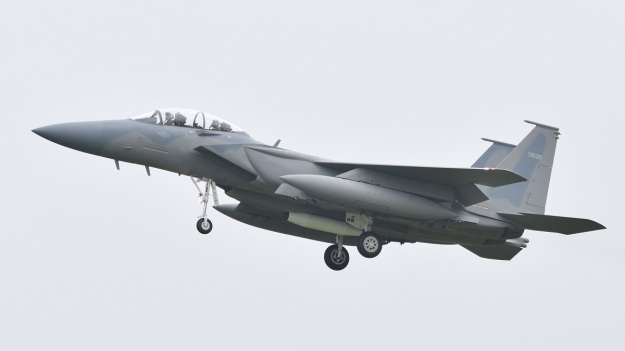 F-15SA with AXQ-14 data link pod
F-15SA with AXQ-14 data link pod
The system includes the weapon data link, an aircraft-mounted data link pod that provides guidance for the GBU-15/AGM-130, and a cockpit control unit for the weapon systems operator. The system is operational on USAF F-111s and F-15s and can be adapted to B-52s, F-16s, F/A-18s and other non-U.S. aircraft.With more than 400 launches accomplished as of early 1995, the AXQ-14 had demonstrated better than 99 percent launch success rate and a mean time between failure rate which exceeded the specification by 300 percent. On 03 April 1995, nearly 13 years after the first delivery, Hughes Aircraft Company turned over to the US Air Force its 3,000th production AN/AXQ-14 Data Link System. Source fas.org
This Is A Fully Armed F-15SA, The Most Advanced Production Eagle Ever
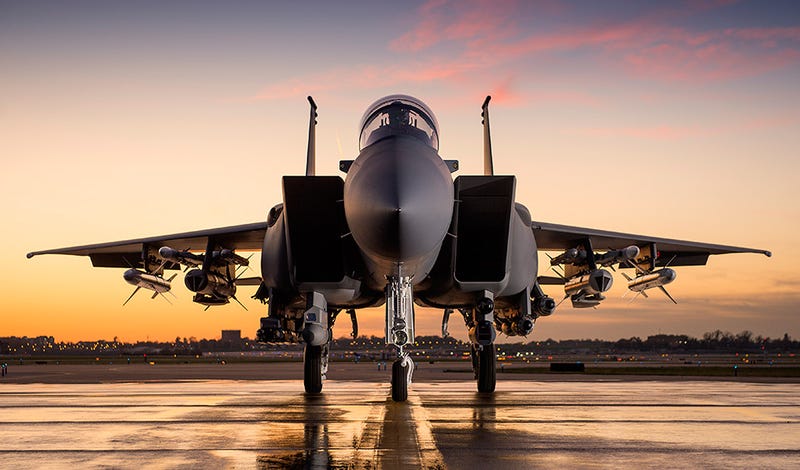 Image: foxtrotalpha.jalopnik.com
Image: foxtrotalpha.jalopnik.com
The F-15SA is the most advanced production F-15 Eagle ever built. Saudi Arabia ordered 84 new build F-15SAs and close to 70 kits to upgrade their existing F-15S fleet to the SA configuration. Just one part of this upgrade is the activation of Eagle’s outboard wing stores stations, which will expand the jet’s already heavy combat punch.
Update: Boeing reached out to tell us they’re marketing the F-15SA configuration for export to other potential users as the “F-15 Advanced.”
The F-15SA is an incredibly capable machine, featuring some key changes from its progenitor, the F-15E Strike Eagle. These include a full fly-by-wire flight control system, APG-63V3 Active Electronically Scanned Array (AESA) radar, digital electronic warfare and radar warning suite, missile launch detection system, updated flat-panel display cockpits with helmet mounted displays in both cockpits and an infrared search and track system, known as “Tiger Eyes,” built into the left intake targeting pod pylon. The F-15SA also features F-110- GE-129 engines, capable of putting out almost 30,000 pounds of thrust each.
When it comes to weapons, the F-15SA can carry almost anything in the inventory. In the incredible image above showing an “extreme multi-role loadout” it packs: 2x AIM-120AMRAAMs, 2x AIM-9X Sidewinders, 2x AGM-84 SLAM-ERs, 2x AGM-88 HARMs, 6x GBU-54/B Laser JDAMs, and 8x GBU-39/B Small Diameter Bombs.
Also, the F-15SA still packs the F-15E’s 20mm Vulcan cannon with 540 rounds available. Basically, with this jet you get a tactical fighter force “in a box.” The loadout shown above includes weapons for long-range stand-off deep-strike, suppression of enemy air defenses (SEAD), counter-air, direct precision attack and standoff precision attack all on the jet at the same time. Even after all that, the F-15SA’s center-line station remains unused, which can accommodate up to a 2,000lb JDAM, an external fuel tank or even a synthetic aperture radar surveillance pod.
 F-15SA is the most advanced production F-15 Eagle ever built – Image: foxtrotalpha.jalopnik.com
F-15SA is the most advanced production F-15 Eagle ever built – Image: foxtrotalpha.jalopnik.com
The image above shows the F-15SA once again, albeit this time it is in an air-to-air configuration, including no less than eight AIM-120 AMRAAMs and eight AIM-9X Sidewinders. This amounts to double the missile carrying capability of the F-15C or F-15E. Also note the Infrared Search and Track system mounted above the jet’s radome. This, combined with its state of the art radar’s low probability of intercept modes, advanced radar warning receiver and Link 16 data-link, allows the F-15SA to hunt for enemy aircraft in electromagnetic silence while still maintain high-situational awareness.
Many of the improvements made in the penultimate F-15SA were also rolled into the even more advanced and stealthier F-15 Silent Eagle, an aircraft that has not found a customer in the fighter marketplace yet, especially since South Korea chose to procure the F-35 on its last fighter buy and other F-15 operators, like Japan, Israel, also did the same. Even if the Eagle line ends with the F-15SA, it is amazing how far the aircraft has come since its original use as an attack aircraft some 30 years ago. Source foxtrotalpha.jalopnik.com
Boeing F-15SE Silent Eagle: Details
 F-15SE Silent Eagle
F-15SE Silent Eagle
Boeing Presents First F-15SA of Saudi Arms Package
The F-15SA first flew at St. Louis on February 20. The USAF said the flight-test program will include three instrumented F-15As flying from Boeing’s St. Louis and Palmdale, Calif., facilities.
Improvements on the F-15SA include fly-by-wire flight controls, a digital electronic warfare suite, Lockheed Martin AN/AAS-42 infrared search and track system and Raytheon APG-63(v)3 active electronically scanned array (AESA) radar. The forward and aft cockpits are equipped for the Joint Helmet Mounted Cueing System enabling the crew to aim sensors and weapons through their helmet visors. The aircraft has two additional wing stations for increased weapons payload capacity.
Saudi Arabia’s F-15SAs and 25 new Lockheed Martin F-16 Block 60 fighters sought by the UAE will be equipped with unspecified advanced “standoff weapons” that have not previously been made available to those countries, according to a senior U.S. defense official. In addition, the U.S. has agreed to supply Israel with advanced weaponry that includes the Bell-Boeing V-22 tiltrotor, KC-135 tankers and AESA radar retrofits.
F-16 E/F Block 60: Details
The Pentagon revealed the weapons packages during a briefing for reporters on April 19 in advance of Defense Secretary Chuck Hagel’s first trip to the Middle East in his new capacity. They represent “one of the most complex and carefully orchestrated arms sale packages in American history,” and resulted from intensive negotiations begun under previous defense secretary Leon Panetta, the defense official said. Israel’s consent was critical. “A key part of the agreement is [that] we believe and the Israelis believe that the provision of these capabilities [will] in no way diminish Israel’s qualitative military edge,” the official said. Original post “Boeing Presents First F-15SA of Saudi Arms Package” by Bill Carey – May 3, 2013, 11:50 AM by AIN Publications – Source ainonline.com

Weapons
M-61A1 20mm Gatling gun
 M-61A1 20mm Gatling gun
M-61A1 20mm Gatling gun
The M61 20mm Vulcan is an externally powered, six-barrel, rotary-fire gun having a rate of fire of up to 7200 spm. The firing rate is selectible at 4,000 spm or 6,000 spm. The gun fires standard electrically primed 20mm ammunition. The M61A1 is hydraulically or ram-air driven, electrically controlled, and uses a linkless ammunition feed system.
Each of the gun’s six barrels fires only once during each revolution of the barrel cluster. The six rotating barrels contribute to long weapon life by minimizing barrel erosion and heat generation. The gun’s rate of fire, essentially 100 rounds per second, gives the pilot a shot density that will enable a “kill” when fired in one-second bursts.
 M-61A1 20mm Gatling gun on F-15C
M-61A1 20mm Gatling gun on F-15C
The M61 20mm cannon is a proven gun, having been the US military’s close-in weapon of choice dating back to the 1950s. The F-104, F-105, later models of the F-106, F-111, F-4, B-58, all used the M61, as does the Air Force’s F-15 , F-16 and F-22, and the Navy’s F-14 and F/A-18. The internally mounted 20mm cannon system is common to all versions of the F-15. This system combines the widely used (F-4, F-16, F-18) M61 cannon with 940 rounds (A through D models) or 500 rounds (E model) of ammunition. The cannon can be loaded with target practice, armor piercing, or high explosive incendiary rounds. The primary use of the cannon is in the extremely short range (less than 2000 feet) air-to-air environment, where more sophistacated air-to-air missiles are ineffective. Alternately, the cannon has limited usefulness in a ground strafing role. Source fas.org
AIM-9X Sidewinder AAM
 Image: donhollway.com
Image: donhollway.com
The current fifth-generation AIM-9X is to the old 9B what humans are to homo erectus. Paired with a pilot’s helmet-mounted display, it can “look” 90 degrees off-boresight for its target and, with three-dimensional vectored-thrust steering, turn 180 degrees in pursuit. One test pilot at Naval Air Station Fallon, Nev., freshly returned from getting every visual-range first-shot “kill” on Top Gun instructors in F-18s and F-14s, enthused, “If you have [a weapons-sight] helmet and AIM-9X, you are King Kong of the air.”
 “Cloud shooting:” Newest versions permit the missile to receive targeting instructions after launch, from other than the launching aircraft. Image: donhollway.com
“Cloud shooting:” Newest versions permit the missile to receive targeting instructions after launch, from other than the launching aircraft. Image: donhollway.com 3D-vectoring nozzle which permits the 9X to turn 180° in pursuit
3D-vectoring nozzle which permits the 9X to turn 180° in pursuit
The latest versions have “lock-on after launch” capability, lending themselves to “cloud shooting,” 360-degree target selection via data link from aircraft other than the launching fighter. Source donhollway.com
AIM-120 AMRAAM Slammer
The AIM-120 advanced medium-range air-to-air missile (AMRAAM) is a new generation air-to-air missile. It has an all-weather, beyond-visual-range capability and is scheduled to be operational beyond 2000. AMRAAM is a supersonic, air launched, aerial intercept, guided missile employing active radar target tracking, proportional navigation guidance, and active Radio Frequency (RF) target detection. It employs active, semi-active, and inertial navigational methods of guidance to provide an autonomous launch and leave capability against single and multiple targets in all environments.

The AMRAAM weighs 340 pounds and uses an advanced solid-fuel rocket motor to achieve a speed of Mach 4 and a range in excess of 30 miles. In long-range engagements AMRAAM heads for the target using inertial guidance and receives updated target information via data link from the launch aircraft. It transitions to a self-guiding terminal mode when the target is within range of its own monopulse radar set. The AIM-120 also has a “home-on-jam” guidance mode to counter electronic jamming. With its sophisticated avionics, high closing speed, and excellent end-game maneuverability, chances of escape from AMRAAM are minimal. Upon intercept an active-radar proximity fuze detonates the 40-pound high-explosive warhead to destroy the target. At closer ranges AMRAAM guides itself all the way using its own radar, freeing the launch aircraft to engage other targets.
 AIM-120C AMRAAM
AIM-120C AMRAAM
Variants
Presently, there are three series of AMRAAM: AIM-120A, AIM-120B, and AIM-120C.
AIM-120A. First production AIM-120A, delivered by Hughes in 1988 to the 33d TFW at Eglin AFB, Florida.
AIM-120B and AIM-120C versions are currently in production, the latter with smaller control surfaces to permit increased internal carriage capability in the F-22. AIM-120B deliveries began in FY 94, and AIM-120C deliveries began in FY 96.
P3I. An improvement program seeks to develop AMRAAM capabilities, including software reprogrammability, advanced counter-countermeasures, and options for improved propulsion.
 AIM-120C AMRAAM
AIM-120C AMRAAM
The AIM-120A is a non-reprogrammable missile (requires a hardware change to upgrade the missile software). The AIM-120B/C is reprogrammable through the missile umbilical using Common Field-level Memory Reprogramming Equipment (CFMRE). The AIM-120C has smaller aero surfaces to enable internal carriage on the Air Force F-22 aircraft. The USAF All-Up-Round (AUR) container houses an internal cable which enables up to four missiles to be reprogrammed while in the container. USN containers are not equipped with the cable and must be opened to reprogram the missile. All three AMRAAM variants are currently approved for use on the F-15C/D/E, F-16C/D, and F/A-18C/D aircraft. Source fas.org
Dual Mode Plus laser-guided bomb (500 & 2,000 lbs)

With the combination of the INS/GPS system, existing semi-active laser (SAL) seeker and anti-jam technology, the DMLGB minimizes collateral damage and improves mission effectiveness by providing precision strike capabilities in all-weather at extended standoff ranges. The DMLGB is effective against fixed, relocatable and moving targets.
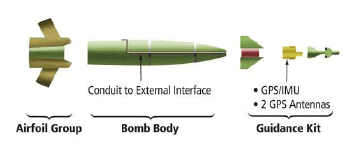 Image: defenseindustrydaily.com
Image: defenseindustrydaily.com
The DMLGB guidance kit is compatible with the MK 82 warhead and standard GBU-12 Airfoil Group (AFG). Over 7,000 DMLGBs have been delivered to the U.S. Navy / Marine Corps and are employed on F/A-18 Hornets, Super Hornets and AV-8B Harrier. Source lockheedmartin.com
GBU-24 Paveway III LGBs (2,000 lbs)

Paveway is a series of laser-guided bombs (LGBs).
Pave or PAVE is sometimes used as an acronym for precision avionics vectoring equipment; literally, electronics for controlling the speed and direction of aircraft. Laser guidance is a form of Pave.
- GBU-24 Paveway III – Mk 84/BLU-109 2,000 lb (907 kg) class bomb
Source wikiwand.com
GBU-31B V3 JDAMs (2,000 lbs)
CBU-105D/B SFW/ WCMD

AGM-84 Block II HARPOON missiles

The Harpoon missile provides the Navy and the Air Force with a common missile for air, ship, and submarine launches. The weapon system uses mid-course guidance with a radar seeker to attack surface ships. Its low-level, sea-skimming cruise trajectory, active radar guidance and warhead design assure high survivability and effectiveness. The Harpoon missile and its launch control equipment provide the warfighter capability to interdict ships at ranges well beyond those of other aircraft.
The Harpoon missile was designed to sink warships in an open-ocean environment. Other weapons (such as the Standard and Tomahawk missiles) can be used against ships, but Harpoon and Penguin are the only missiles used by the United States military with anti-ship warfare as the primary mission. Once targeting information is obtained and sent to the Harpoon missile, it is fired. Once fired, the missile flys to the target location, turns on its seeker, locates the target and strikes it without further action from the firing platform. This allows the firing platform to engage other threats instead of concentrating on one at a time.
| Primary Function: | Air-to-surface anti-ship missile | |||
| Mission | Maritime ship attack | |||
| Targets | Maritime surface | |||
| Service | Navy and Air Force | |||
| Contractor: | Boeing [ex McDonnell Douglas] | |||
| Power Plant: | Teledyne Turbojet and solid propellant booster for surface and submarine launch | |||
| Program status | Operational | |||
| sea-launch | air-launch | SLAM | SLAM-ER | |
| First capability | 1977 | 1979 | ||
| Thrust: | 660 pounds | |||
| Length: | 15 feet (4.55 meters) |
12 feet, 7 inches (3.79 meters) |
14 feet, 8 inches (4.49 meters) |
|
| Weight: | 1,470 pounds (661.5 kilograms) |
1,145 pounds (515.25 kilograms) |
1,385 pounds (629.55 kilograms) |
|
| Diameter: | 13.5 inches (34.29 centimeters) | |||
| Wingspan: | 3 feet (91.44 centimeters) | |||
| Range: | Greater than 60 nautical miles | 150+ miles | ||
| Speed: | 855 km/h | |||
| Guidance System: | Sea-skimming cruise with mid-course guidance monitored by radar altimeter, active seeker radar terminal homing | inertial navigation system with GPS, infrared terminal guidance | ||
| Warheads: | Penetration high-explosive blast (488 pounds) | |||
| Explosive | Destex | |||
Data fas.org
AGM-88B HARM missiles
The initial AGM-88A was supplanted in the late eighties by the improved AGM-88B, which provided a field reprogrammable seeker, rather the factory reprogrammable seeker of the initial variant. Source ausairpower.net
The AGM-88 HARM (High-speed Anti-Radiation Missile) is an air-to-surface supersonic, long range missile designed to seek out and destroy enemy radar systems. It was designed as an advanced follow on to Standard ARM and Shrike anti-radiation missiles. The HARM’s guidance package, with full frequency coverage, is locked on enemy’s radar systems emissions following them through radar site. Radar systems physical destruction is achieved through a single blast fragmentation warhead. The first combat use of AGM-88 missiles was in Libya in 1986. During the gulf war in 1991, more than 2,000 HARMs were fired against Iraq’s radar systems becoming the weapon of choice in the suppression of enemy air defenses (SEAD). The HARM missile can be released from many aircraft. The F-16C is the only HARM-capable aircraft of the US Air Force.
The HARM missile can operate in three modes: pre-emptive, missile-as-a-sensor and self-protect. In the pre-emptive mode the missile is fired before locking on the potential threat. Targeting is provided through pre-flight planning or cued via aircraft’s sensors. The missile-as-a-sensor mode allows aircraft to use externally attached HARM missiles as a sensor (using its seeker) to locate radar emissions. Self-protect mode means the missile is fired to destroy threatening radar emissions.
Dimensions
Diameter: 250 millimeter
Length: 4.17 meter
Wingspan: 1.13 meter
Performance
Max Range: 105 kilometer
Speed
Top Speed: 630 mps (2,269 kph)
Weight
Warhead: 68 kilogram
Weight: 360 kilogram
Source deagel.com
General Electric F110-GE-129
Manufacturer: General Electric Co.
Thrust: F110-GE-129: 29,500 pounds; F110-GE-132: 32,000 pounds
Overall Pressure Ratio at Maximum Power: F110-GE-129: 30.7; F110-GE-132: 33.3
Thrust-to-Weight Ratio: F110-GE-129: 7.29; F110-GE-132: 7.90
Compressor: Two spool, axial flow, three-stage fan
LP-HP Compressor Stages: 0-9
HP-LP Turbine Stages: 1-2
Combustor Type: Annular
Length: 182.3 in (4.63 m)
Diameter: 46.5 in (118 cm)
Dry Weight: F110-GE-129: 3,980 lbs (1,805 kg); F110-GE-132: 4,050 lbs (1,837 kg)
Platforms: F-16 Fighting Falcon; F-14 (retired); F-15K Slam Eagle; F-15SA; F-15SG; F-2
Source fi-powerweb.com
Updated Dec 25, 2017
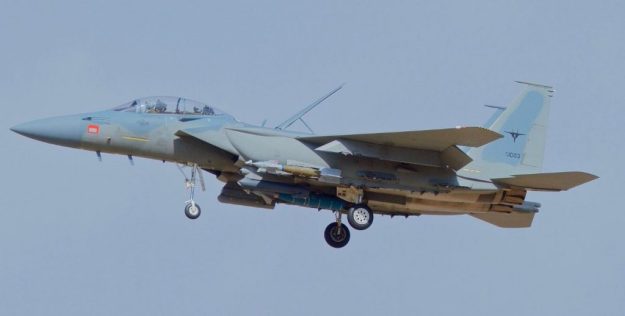 Image: aereo.jor.br
Image: aereo.jor.br
Saudi F-15SA basing and unit plans revealed
The US government has revealed basing and unit plans for the Royal Saudi Air Force’s (RSAF’s) Boeing F-15SA (Saudi Advanced) Eagle fleet ahead of the commencement of deliveries.
The details were disclosed in early August in a Federal Business Opportunities (FedBizOpps) request for information (RfI) for F-15SA support that will run from March 2017 until March 2021.
According to the solicitation, the F-15SA will be operated by 55 Formal Training Unit (FTU) and 6 Squadron (currently an F-15S unit) at King Khalid Air Base (KKAB) in the south-west of Saudi Arabia; 29 Squadron (not currently stood-up) at King Faisal Air Base (KFAB) in the north-west of the country; and 92 Squadron (currently an F-15S unit) and the Fighter Weapons School at King Abdulaziz Air Base (KAAB) on the Gulf coast near Bahrain.
The RSAF is to receive 152 F-15SAs, of which 84 will be new build and 68 will be remanufactured F-15S platforms. Procured under a USD29.4 billion Foreign Military Sale (the largest in US history), the F-15SA is the most advanced variant of the Eagle ordered to date. Enhanced features include upgraded avionics (with a digital ‘glass’ cockpit); a BAE Systems Digital Electronic Warfare System/Common Missile Warning System (DEWS/CMWS); fly-by-wire controls; an infrared search-and-track (IRST) system; and the Raytheon APG-63(V)3 active electronically scanned array (AESA) radar. The aircraft will also be fitted with new flight control components/surfaces from Goodrich and the F-15S Pratt & Whitney F100-PW-229 powerplant will be replaced with the more powerful General Electric F110-GE-129.
Both the front and rear cockpit positions feature joint helmet-mounted cueing systems, and the two outermost underwing weapon pylons have been activated to increase the aircraft’s hardpoints to 11. New weapon systems, including the latest-generation AIM-9X Sidewinder short-range air-to-air missile and an assortment of air-to-surface and anti-shipping weaponry, have also been ordered. Gareth Jennings, London – IHS Jane’s Defence Weekly 08 August 2016 – Source janes.com




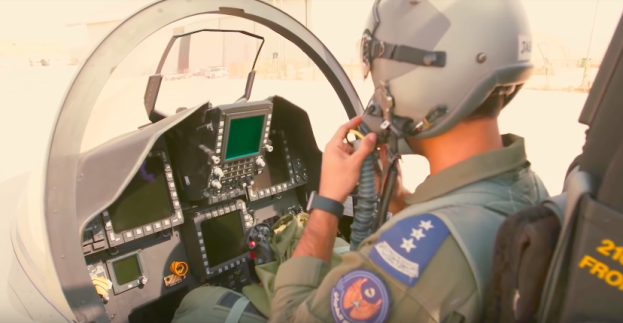 F-15SA cockpit
F-15SA cockpit WSO
WSO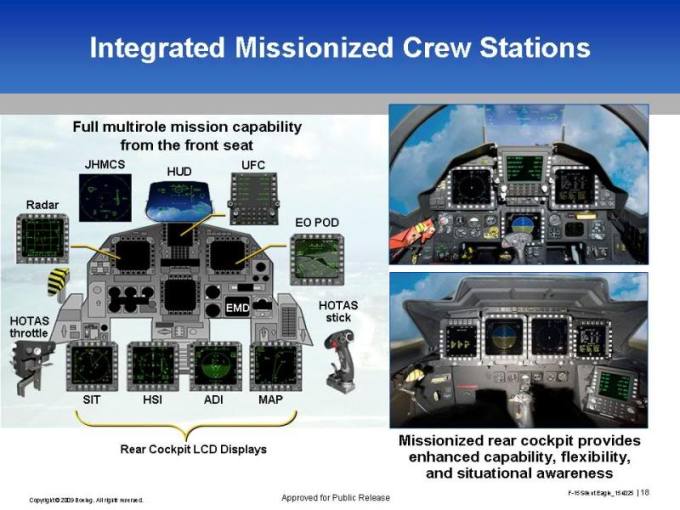
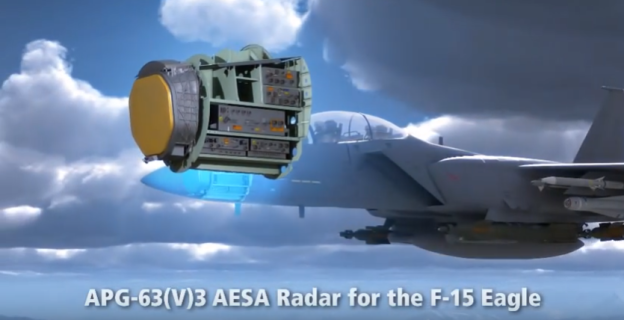 Image: Raytheon
Image: Raytheon



